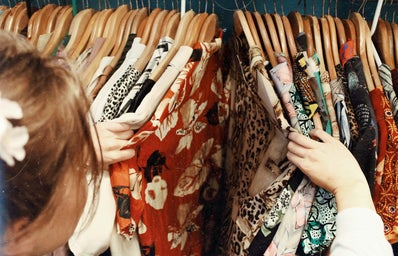Let’s start with the latter, why I buy second hand. It all leads back to the fast fashion industry and its detrimental effects on people and the environment.
- We have all seen the photos of fast fashion workers in the global South, working unfathomable hours in unfair working conditions at tedious jobs. The fashion industry has taught us to see the item of clothing and not to look beyond that, to the people that actually produce those clothes. Advertising and branding establish a symbolic value of clothing, therefore easily increasing the price to more than it is worth. Brand owners extract the surplus, and the fruits of production are extremely unfairly distributed. If we actually saw the clothes in our wardrobe as people and if we saw the hours they put into making that garment that was sold for less than what the worker deserves to be paid, I’m sure we would think twice. Salaries of workers are too low to support a secure livelihood. Labour becomes subservient to the interests of capitalists, rather than the subsistence of workers. The collapse of the Rana Plaza factory in Bangladesh in 2013 demonstrates the poor working conditions that we are indirectly allowing when we buy fast fashion. 1,134 people died, people working from brands such as Mango, Primark, and Matalan.
- Fast fashion is a system of extraction which utilises cheaper resources and labour forces to feed into the richer multinational corporations (MNCs) of the global North. It is quite simply a form of neo-colonialism, and traps these countries into structures of dependency in which there is no way to free themselves. I am choosing in my own small way to boycott this system.
- Of course, fast fashion is massively detrimental to the environment too. For example, 1800 gallons, or 8000 litres, of water are needed just to grow enough cotton for one pair of jeans. But there are many more environmental impacts of constantly producing things that we really do not need that I will not touch on here. Don’t forget the environmental costs of transportation too. With free next-day delivery being offered by companies, it is easy to get sucked into ordering one item at a time and getting multiple deliveries a week. That is extra journeys that a delivery driver will be making, emitting more carbon dioxide into the atmosphere.
- A simple one is, why am I spending so much money on clothes that in a few weeks I am bored of? After stepping away from fast fashion, I realised how much money I can save and the stupidity of the whole system.
Now to charity shops. Charity shops are just another tool in the system that allows fast fashion to rule our lives by helping us to justify the constant repurchasing of clothes. It also has effects that the industry has brainwashed us to look beyond, to be thoughtless of, because if we see the truth, I’m sure many of us would decide to change, and in doing so these companies would lose their customers.
Why I choose not to donate to charity shops and instead sell online:
- Only a minority of the clothes are actually put out in the shop – the rest go to ‘poor’ and ‘needy’ countries. The UK is in fact the second largest exporter of second-hand clothes to the global South. A huge 81% of all clothes sold in Uganda are second hand. In viewing this pattern of clothing distribution, people in the main unquestioningly accept that it can only bring benefits to poor people in the global South, which reinforces the popular idea that clothing donations must be doing good. The reality though is not so straightforward. Firstly it undercut their previously thriving domestic clothing markets (which were successfully making profit and serving domestic demand, creating a prosperous internal economy), leaving them in a worse position. As a result, domestic clothing factories fail, livelihoods are destroyed and income declines, reducing Africans’ purchasing power, which in turn depresses demand.
- For those that do make a living from charity shop leftovers in the global South, it is still very precarious. When store vendors buy the bundles of clothes, they do not know what they are getting – African clients have to accept a mixed packing list of different categories of 45kg clothing bales in container shipments. They have no agency in determining their stock and quality, which may leave them unable to sell certain bundles, leaving them out of pocket. They are not permitted to select the items they would prefer. Undesirable items do not suit the climate of the country and sell for low prices. The market conditions, where demand normally exceeds supply, are taken advantage of by organisations like Oxfam, the Salvation Army and Ragtex, enabling them to profit from less desirable, bulky, cold weather and unfashionable items. This shows how exporters in the global North have ascendancy over their customers in the global South. Again, this is an unfair neo-colonial system whereby the global North supposedly ‘helps’ the global South, but this is in fact a veil over their true intentions of profit-making and the reality of underdevelopment.
- The absurdity of the situation is clear. When those in sub-Saharan Africa wear second-hand clothes, they think of these clothes as ‘clothes of the dead whites’. The over-production and dumping of clothes seems so irrational that they cannot fathom that we just don’t want the clothes anymore
- There are also environmental issues. For years, a large proportion of donated goods have been sent to landfill (or the incinerator) or sent for recycling. We’ve been treating the charity shops like a bin. But largely, the mindset is that ‘as long as it is out of my hands, then I don’t care to think of the consequences’. It highlights the superior position we, as consumers in the global North, have been conditioned to view ourselves in, by companies that need us to think this way so we buy more clothes!
Social media is perpetuating this situation. We are conditioned to constantly want more, to show more, and social media has become a vehicle to condition our minds, with influencers constantly showing the ‘unboxing’ of clothes. If these are the people we are to aspire to, what do we expect?
Of course I am not accusing people of crimes when they buy fast fashion – everyone does it, it is just part of our culture. I had the opportunity to look critically at this situation; before, I was just as bad as everyone else. It is hard to escape the system when you want to be part of the fashion game, and your mind is conditioned to get bored of your clothes within a day. But I can honestly say that since I’ve committed to not buying fast fashion, I have no urge to have a quick scroll on ASOS. Once you tell yourself the reasons behind it, combined with the decision to refrain from it, your mind loses interest.
BUT you can (and I do) still enjoy fashion and buy amazing clothes, just second hand. Sites like Depop and Vinted are great. Obviously, this is still perpetuating the system by engaging in the recycling of clothes, rather than tearing it down and sticking with long lasting garments, but it is at least a step forward. If we are living in a society that is constantly changing fashion and do not want to feel left behind, buying second hand is the best way forward because it boycotts the fast fashion retailers and stops clothes being dumped on people who do not want them or in landfill.d, buying second hand is the best way forwards because it boycotts the fast fashion retailers and stops clothes being dumped on people who do not need them or in landfill.
The constant cycle of clothes is having detrimental effects on societies and on our environment, but we are only powerful enough to stop it if we work as a collective, otherwise the MNCs have the power – and when the rich are rich, they are never going to stop.
Sources:
https://www.thefashionlaw.com/how-many-gallons-of-water-does-it-take-to-make-a-single-pair-of-jeans/



